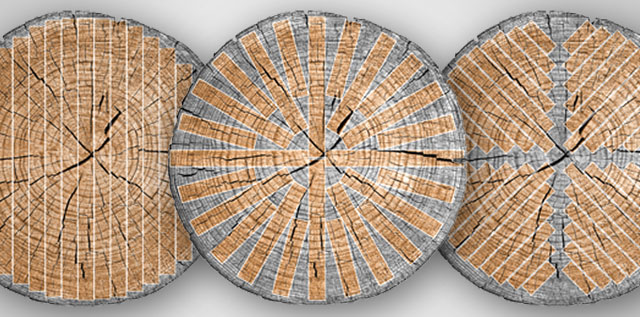
Four Cuts of a Log – Live Sawn, Plain Sawn, Quarter Sawn and Rift Sawn Milling
There are many ways to divide a log into flooring boards, and while shopping for flooring, you’ll encounter them all. The key is to know what you’re looking at, what you’re looking for, and what you want. We’ll try to shed some light on the most common methods used and describe a little about each.
While shopping for your “forever” floor, there are several factors to consider that contribute to the cost, quality or appearance. While it’s easy to see the difference between wide plank flooring and narrow, strip flooring, some of the other factors aren’t so. Have you ever seen a floor, cabinet or kitchen table that had that extra special “something” to it? Chances are it’s due to the specific “cut” of lumber used in it. There are many ways to divide a log into flooring boards, and while shopping for flooring, you’ll encounter them all. The key is to know what you’re looking at, what you’re looking for, and what you want. We’ll try to shed some light on the most common methods used and describe a little about each.
The quick and easy version: We’re talking about the grain patterns and their significance in appearance, quality and cost. As we mentioned above, you can buy the same species of hardwood floor in many different combinations. The milling methods used to manufacture the floor will give it a specific character or appearance. To visualize what we're talking about, refer to the diagram below.
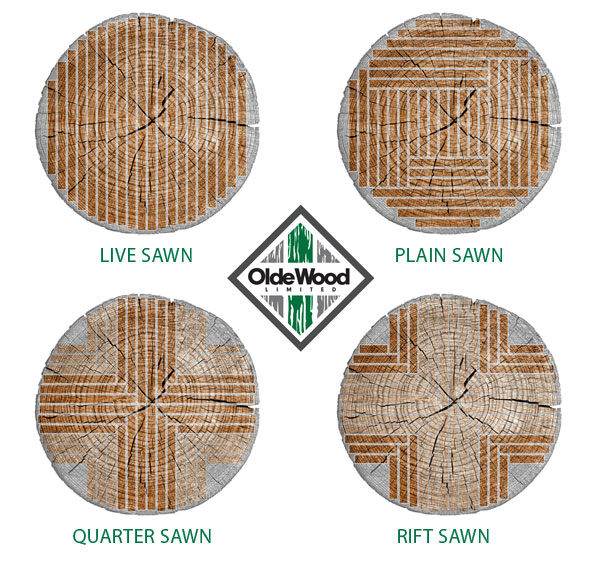
LIVE SAWN MILLING – MOST EFFICIENT, BLENDED MIX OF ALL CUTS.
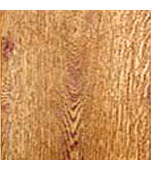
Live sawn milling is the most efficient way to cut a log into flooring planks and it is a newer milling method than the others. Each plank is cut straight off of the log in one direction without changing the orientation of the log. This method produces boards with a full range of angles of the log's rings, also known as the log's "grain". The names of these angles can get pretty technical, but we will spare you the details - the angles range from 0 to 90 degrees or so. Live sawn planks include a full range of the log's characteristics, from the sought-after heartwood where the ring patterns are tightest to the sapwood.
Plain Sawn Advantages: A material efficient floor with beautiful mixtures of all milling methods included.
Shop for Live-Sawn Wood Floors
Love the appearance of live sawn wood? Check out Olde Wood's "Traditional" product line, which features rustic wide plank flooring milled using live sawn techniques
PLAIN SAWN MILLING – MORE EFFICIENT MIXTURE OF CUTS USUALLY FOR GRADING AND SORTING PURPOSES.
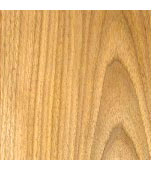
Plain sawn milling, also known as "flat" sawn milling, is the most common way to cut a log into flooring planks today. While it is still a more efficient milling method, more material waste is produced than in live sawn milling. The planks are cut so that the angles of the rings are no more than 35 degrees. The resulting grain pattern on the face of the flooring plank resembles dark cathedral shapes and patterns.
Plain Sawn Advantages: Although not as efficient as live sawn, plain saw milling is still material efficient and has beautiful grain patterns..
QUARTER SAWN MILLING – MORE EXPENSIVE THAN PLAIN SAWN, PRODUCES MORE WASTE MATERIAL.
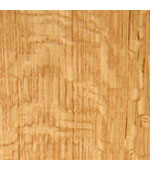
This is a commonly known milling cut in high-end furniture and tables sold as “Quarter Sawn Oak” and such. This cut produces an amazingly straight, striped grain with distinctive “ray and fleck” patterns mixed throughout in red and white oaks. During milling, the log is first quartered lengthwise resulting in wedges with right angles ending towards the center of the log – intersecting the board face at 60 to 90 degree angles. Due to this process, quarter sawn boards are typically narrower than plain sawn boards because the log is first quartered – which is a more wasteful method.
Quarter Sawn Advantages: Dramatic grain patterns with beautiful flecking in oak species – matching the “mission style” design found in American history. Dimensionally stable and generally more resistant to moisture penetration.
RIFT SAWN MILLING – MOST EXPENSIVE, PRODUCES MOST WASTE MATERIAL, LEAST COMMON.
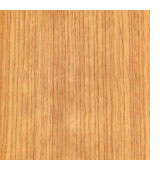
Rift sawing is the most expensive and rare of the milling methods, though sometimes it is mistaken for quarter sawn boards as they are commonly milled as a compliment to a quarter sawn floor. The boards are milled perpendicular to the tree’s growth rings. This produces a noticeably straight grain pattern with no flecking present. In rift sawn milling, the log's growth rings range from 30-60 degrees to the face of the board, with 45 degrees being the optimum. Due to the extreme amount of waste from the rest of the wood, Rift Sawn flooring is extremely rare and expensive. However, with that expense comes beauty and greater stability. Rift sawn boards are extremely stable and produce a uniquely linear appearance.
Rift Sawn Advantages: Produces the strongest possible boards with the most consistent visual look of long and straight grain patterns. Generally the choice of cut for fine furniture makers looking for consistent patterns throughout their design.
These are the most common ways to mill a log into flooring planks. By no means, though, is one way far superior to any of the others. Many factors determine the value of a hardwood floor and you’ll find that many manufacturers divide, include or exclude these cuts differently from floor to floor – some even separate them entirely with extra charges added to each style. You may also notice terms such as “rift and quartered” where two styles are combined to achieve a specific look. What you need to decide is what look best matches your style.
For us, we prefer to not separate the different cuts of wood from a log. Our preferred method of live sawing purposefully includes all grades of lumber, while preserving as much of the resource as possible. It also allows us to produce planks much longer and wider than what you'll find on any shelf at a big-box store. We feel live sawing is the most responsible way to harvest wood for flooring and most closely replicates milling "the way they used to do it".